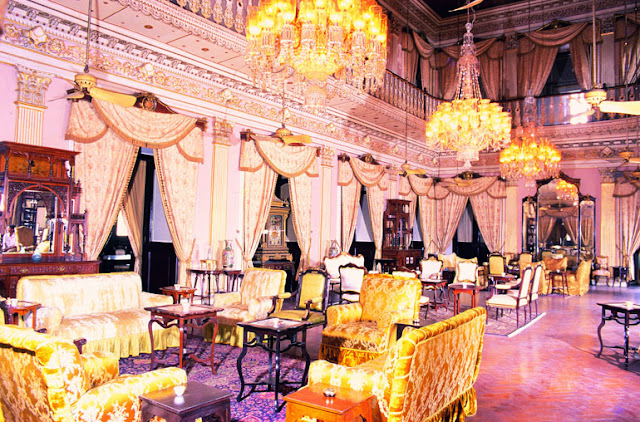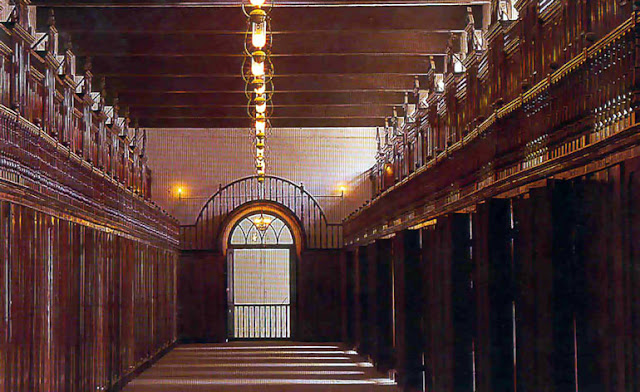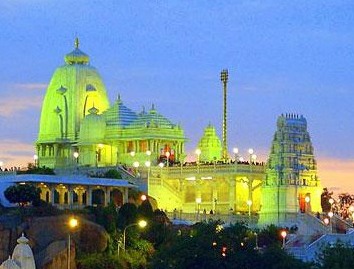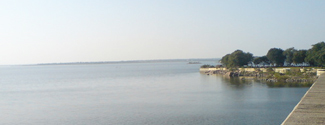Hyderabad
Hyderabad Tourist Attractions, Pictures, Photos, Travel Information, Sites to See, Weather, Best time to visit, Shopping, How to Reach by Road by Train, by Air, Flight
There are a variety of tourist attractions in Hyderabad, a city with a 400-year-old history and a rich blending of cultures. This "city of pearls" has heritage monuments, lakes, parks, gardens, resorts, museums and delectable cuisine that lure tourists. It is known for its interesting diamond markets, pearls, glass embedded bangles and beautiful sarees.
Major Tourist Spots in Hyderabad
Charminar : One of the major historical sites worth visiting is the Charminar, situated in the heart of the city. It is an important landmark in Hyderabad. Hyderabad is famous for pearls, which are sold in shops around the Charminar.
 |
| Charminar |
Char Kaman: Near the Charminar stand four magnificent arches called Char Kaman, which served as the gateway to the Zilu Khana (ante chamber) of the royal palace.
 |
| Char Kaman |
Mecca Masjid : Then there is the Mecca Masjid, one of the largest mosques in India, located just nearby the Charminar.
 |
| Mecca Masjid |
Golconda Fort : Another tourist attraction here is the Golconda Fort, a 16th century fortress situated on the western outskirts of Hyderabad city. Known for its collection of diamonds, it is said that the famous Kohinoor originally belonged to Golconda.
 |
| Golconda Fort |
Falaknuma Palace : The last Nizam of Hyderabad built the Falaknuma Palace, which housed the most expensive art objects, tapestries and carpets, in addition to the largest single-man collection of diamonds. Here the Nizam had received their Majesties, the late King George V and King Edward VIII of England.
 |
| Falaknuma Palace |
Chowmahalla Palace: Chowmahalla Palace is near the Charminar. It comprises of four palaces. The Asif Jahi dynasty made this palace as their seat. The official guests as well as royal visitors were entertained here. The heart of the Chowmahalla Palace is called Khilwat Mubarak, and houses the Clock Tower, Council Hall and Roshan Bungalow. Roshan Bungalow was named after the sixth Nizam’s mother, Roshan Begum.
The palace was restored and opened to public in January 2005. After five years of documentation and restoration work, the first courtyard regained its former glory.
The palace is open to visitors between 10 am and 5 pm. It is closed on Fridays and on national holidays. Entry fee is Rs 25 for Indians and Rs 150 for foreigners.
 |
| Chowmahalla Palace |
Kilwat Palace: The fabulous Nizams’ jewels, which have been taken back to be stored in the vaults of the Reserve Bank of India in Mumbai, are expected to be permanently housed in the famous Khilwat Palace, part of the Chowmohalla Palace complex in the Old City. Once the renovation of the Chowmohalla complex is completed, the Khilwat Palace, where the Nizams’ used to hold court, would permanently house the jewellery.
As part of preparing Khilwat as the permanent site for exhibiting the 173 piece jewellery collection valued at more than Rs 14,000 crore in the international market, a team of reputed architects are working on the plans, not only for the renovation of the palace but also with respect to the security requirements, it was learnt.
The jewellery collection, that was first exhibited at the National Museum in New Delhi and then in the Salar Jung Museum here for more than six months, was taken to the RBI in Mumbai for safe keeping till permanent arrangements are made for their exhibition in the city. The exhibition at the Salar Jung Museum ended on June 30.
“It is only proper that the jewellery of the rulers of Hyderabad are housed in one of their palaces,’’ the source said. Though the site for the permanent facility for the exhibition of the jewellery has not been made official yet, work on converting the Khilwat Palace into a gallery is expected to be completed in a little over a year from now.
Meanwhile, Princess Esra, the first wife of Prince Mukarramjah Bahadur, is planning to make the once famed Chowmohalla complex in the Old City, the hub of cultural and literary activities. Princess Esra wants to bring back to the city what it was once famous for. For this purpose, the Chowmohalla complex is being renovated.
 |
| Kilwat Palace |
Purani Haveli: Purani Haveli lies to the southeast of Afzal Gunj Bridge near Dewandevdi in Hyderabad. Purani Haveli is a U shaped complex with a single storied central building in European style, bordered by two double storied oblong wings.
Purani Haveli (lit. 'Old Quarters') was originally established and designated to be the residential quarters of Mir Momen, the Peshwa(Prime Minister) of Mohammed Quli Qutub Shah in the late sixteenth century. It was acquired by Nizam III in the eighteenth century to renovate and designate it to be his son's (Sikandar Jah's) quarters. When Sikandar Jah decided to move to the Khilaurat complex, this place came to be known as Purani Haveli .
This architectural landmark of Hyderabad reflects the combination of 18th century European facades with traditional Indian courtyards. Two annexes are attached to the northern ends of the parallel wings. The 18th century European architecture is reflected in the main building which has many interesting pieces of antique furniture. One can see two vast courtyards surrounded by rooms and deep verandahs with semicircular European arches. It was built during the reign of the Asaf Jahis. Some rooms still have their tiled walls and mosaic flooring intact, and their multitude colours recall the past glory of the palace. A library and the Mukarram Jah Technical Institute form part of the complex. A museum with seventh Nizam's collection of gifts is also seen.
 |
| Purani Haveli |
Qutub Shahi Tombs: Qutub Shahi Tombs are located in the heart of the Hyderabad city. The Qutub Shahi Tombs are quite close to the Golconda Fort, which is a famous landmark of Hyderabad. The Qutub Shahi Tombs are a perfect blend of Indian and Persian architectural forms, constructed in gray granite decorated with exquisite ornamentation. The tombs are domed structures, which are built on an elevated square base surrounded by pointed arches. Each tomb is quadrangular and rises to a height of 9 - 15 meters above the terrace. The smaller tombs are single storied while the larger ones are double storied. The domes were originally covered with blue and green tiles, of which only a few pieces remain now.
The tombs were once furnished with carpets, chandeliers and velvet canopies on silver poles. Qurans or the holy book of the Muslims, were kept on supports and readers recited verses from the sacred book at regular intervals. Golden spires were fixed over the tombs of the Sultans to distinguish their tombs from those of the other members of the noble family.
Enchanting minarets at the corners surround the Qutub Shahi Tombs. This magnificent tomb is one of the largest monuments in Hyderabad reaching upto a height of 42 meters with a large dome adorning the top. The architect has prudently designed it on a double terrace, elevating it to a height of 6 meters from the ground level of the terrace. These mausoleums of the Golconda Sultans are truly splendid monuments that have stood the trial of time and braved the natural elements. During the Qutub Shahi period, these tombs were held at such high esteem that criminals who took refuge there were pardoned and let off. But after their rule, the tombs were uncared for. Later, Sir Salar Jung III ordered their renovation and refurbishment in the early 19th century.
Said in simple words, these monuments are a work of splendid beauty and artistry. The numerous tombs of the members of the royal family, laid beautifully on the sprawling gardens are worth the visit. Not only are they architecturally impressive, they also make a good picnic spot. Another attraction of these tombs is that every year the State Government authorities conduct a 'Deccan Festival', which is exclusive to the city of Hyderabad with these tombs as the backdrop as they speak volumes about the history of the city of Hyderabad. One can spot many renowned artists showcasing their talents in various fields like music, dance and theater.
 |
| Qutubshahi Tombs |
Husain Sagar Lake : In 1562,Ibrahim Qutb Shah built Husain Sagar Lake, a large artificial lake, 1562 AD and is the connecting point of the twin cities of Hyderabad and Secunderabad. In the lake on an island there is a larger -than -life size statue of the Buddha. Boats take tourists across the lake to the island, on which the statue rests.
 |
| Hussain Sagar |
Salar Jung Museum : Salar Jung Museum is one of the most visited places in the city. With a collection of fine art, tapestries, jade artifacts, weaponry and sculpture, it is worth seeing. Naubat Pahad, a hilltop crowned by the Birla Temple is a tourist spot affording lovely views of the city. Kasu Brahmanda Reddy National Park is a nature park situated near Jubilee Hills.
 |
| Salarjung Museum |
Birla Mandir:An enchanting temple dedicated to Lord Venkateswara, the Birla Mandir of Hyderabad, India stands in its entire splendor on the hilltop of Kala Pahad. Made of pure white marble from Rajasthan, the Birla Mandir overlooks the serene and placid waters of the Hussain Sagar Lake. The famous Birla industrialist who had built a large number of temples all over India built the Birla temple of Hyderabad. They finished building the Birla Mandir of Hyderabad within a time span of ten years. The magnificent shrine offers a wonderfully breath-taking view of the twin cities of Hyderabad and Secunderabad.
The intricate carvings of the temple, the ceiling and the mythological figures are a standing testimony to the dexterity and sculptural excellence of the craftsmen. Beautiful scenes from the great epics of Ramayana and Mahabharata are finely sculpted in pure white marble. The temple is devoted to Lord Venkateswara who is also known as Balaji, though the temple is known as Birla Mandir. It is a wonderful blend of the architectural style of northern and southern temples.
As you enter the temple you can see the 'Gopuram' or the pyramid shaped temple top, which is a characteristic feature of South Indian temples. The tower situated at the top of the principal deity called the Jagadananda vimanam is again built in the Orissan style. The flagstaff of the temple is made up of brass, and reaches to a staggering height of 42 feet.
The granite stone, out of which the idol of Lord Venkateswara has been carved, is about 11 feet tall. A Lotus shaped canopy at the top of the idol is again done in marble and looks stunning. Along the winding path that leads to the main worship place, are many marble statues of Gods and Goddesses of Hindu mythology that look almost real. In case you visit the temple in the early hours of the day, you can hear some very melodious South Indian music in the praise of the Lord. The Birla Mandir of Hyderabad becomes a spectacular sight in the evening when it is illuminated with hundreds of bright lights.
 |
| Birla Mandir |
Hyderabad Botanical Gardens : Hyderabad Botanical Gardens is the first Botanical Garden in Andhra Pradesh that is coming up in stages in Kotaguda Reserve Forest near the Hi-tech city, Madhapur. Lumbini Park situated near the Hussain Sagar, also popularly known as Tank Bund. The Public Gardens are one of the largest gardens in the city. One of the most recent and glamorous attractions of Hyderabad, NTR gardens spread over 34 acres is absolutely unique with large-scale use of fiberglass in the form of insects and fruits. Sanjeevaiah Park is a major recreation center located next to Hussain Sagar, at the end of Necklace Road, in Hyderabad.Indira Park is a recreation park for children, situated near lower Tank Bund. which offers boat rides. Snow World is the World's Biggest and India's 1st Snow Theme Park, behind Indira Park on Lower tank Bund Road. Artificially produced snow is using state of the art technology is an attraction.
 |
| Botanical Gardens |
Nehru Zoological Park : Nehru Zoological Park is a sprawling zoo, which follows the open plan model and ensures the animals are seen in naturalistic surroundings. The crocodile hatchery and lion safari are prime attractions.
 |
| Nehru Zoological Park |
Durgam Cheruvu : Durgam Cheruvu is situated close to Shilparamam Crafts Village and Hitech City, behind Jubilee Hills. AP Tourism organises boating in Durgam Cheruvu lake which is surrounded by hills of the Deccan Plateau.
 |
| Durgam Cheruvu |
Gandipet Lake(Cheruvu) : Gandipet Lake located at a distance of 20 km. from Hyderabad and also called as Osman Sagar has well laid out lush green gardens and a swimming pool and is a very popular picnic spot for the city crowd.
 |
| Gandipet Lake |
Shameerpet : Shameerpet, about 24kms away from the city, towards the north of Secunderabad has a deer park and a lake with cottages around the place.
 |
| Shameerpet Deer Park |
Dhola-ri-dhan : Dhola-ri-dhan on Medchal Road opens the doors to the world of ethnic Rajasthani resort of culture where the visitors can experience the true Rajasthani life style and enjoy the artforms.
 |
| Dholari Dhani |
Entertainment Venues : The Alleygator has emerged as a favorite funcentre for the young as well as old people with four lines of bowling alleys, six pool tables, and video games. Runway9-Go Karting is the happening place for go-karting. Ocean Park is a one of its kind water theme amusement park modeled on International standards. Other attractions in Hyderabad are Ramoji film city, an amazing place located at an hours drive form the airport of Hyderabad which gives a choice of numerous flexible locations, which are as varied as a picturesque Indian village or a street in Switzerland.
Shilparamam : Shilparamam, located at Madhapur village showcasing the various art forms and handicrafts of various artists from all over the country. Birla Planetarium is situated on a hill near the Birla Temple and offers educational shows as well offers a fine view of the city.
 |
| Shilpa Ramam |
Ramoji Film City: The Ramoji Film City is located about 35 kilometers from the Hyderabad city. A tour to the Ramoji Film Studio will tell you why is it acknowledged by the Guinness Book of World Records as one of the largest film studios in the world. The studio lives upto its name of a "city" as it is spread over a vast area of around 2500 acres. You feel as if you have entered a new city all together with hills, gardens, lakes, and at the same time flanked with spotless modern buildings.
The Ramoji Film City doubles both as a tourist attraction and major film-making facility. The city looks like the product of an alliance between the famous magician P.C. Sorkar and Vishwakarma, the God of Architecture and Engineering. It is India's answer to the Universal Studios in Hollywood, in every aspect. It is a place where realism obtains all the traits of enchantment and inconceivable. Today, it is the filmmakers' first choice as it is a single-window, press-button facility that opens up an unlimited arena of creativity for every major and minor aspect of film production.
As some famous directors and producers put it, "The Film City has all facilities at one place with latest technology and advanced equipment." The studio's brochure highlights its dictum as "Make the Magic Happen". The magic however happens impulsively without human intrusion as though it is the key ingredient of the entire project. Yet, everything in the studio is real, whether it is the 50 studio floors, outdoor locations, high-tech laboratories, state-of-the-art technology and the lush green landscape and scenery.
 |
| Ramoji Film City |
How to Reach Hyderabad
It is easy to reach Hyderabad, the capital of Andhra Pradesh because it is well connected to other major cities and states by air, rail and road.
By Air: Hyderabad is well connected to national and international destinations with both national and international air carriers.
Hyderabad has two airports, the Rajiv Gandhi Terminal is the international airport and the N. T. Rama Rao Terminal is the domestic airport in the city.
By Train: The Indian Railway, the world's largest railway under a single management, is divided into nine zones. Secunderabad, the twin-city of Hyderabad, is the headquarters of the South Central Zone. Hyderabad is the major point of arrival or departure. Hyderabad railway station is well connected to all the major Indian cities with a number of daily express trains from Hyderabad to the other cities of India.
By Road: Hyderabad has a large bus terminus and is well connected to other cities in the state by a network of highways.The Andhra Pradesh State Road Transport Corporation (APSRTC) buses and buses belonging to other South Indian State Roadways also operate from here. The APSRTC also conducts a number of tours and excursions around the city. The Andhra Pradesh State Road Transport Corporation (APSRTC) connects Hyderabad to every city, town and all except very small villages in the state. Express and luxury coaches are available for inter-city and interstate services. The APSRTC city control is at Ranigunj Depot at Secunderabad. Several private travel services run by tour operators/travel agents are also available.
Travel in Hyderabad: Taxis, auto rickshaws and other smaller vehicles are available for local transportation. One can get prepaid taxis and auto-rickshaws to and from the Airport. Chauffeur driven private cars and taxis for long distance travel are available in Hyderabad, operated by Andhra Pradesh Travel and Tourism Development Corporation (APTTDC) and private operators. Local Bus services within Hyderabad city are good. Hyderabad has a light rail transportation system known as the MultiModal Transport System(MMTS),running close to 30 services a day, connecting Secunderabad and Lingampally on the city outskirts. Its unique feature is the connectivity between rail and road transport for the facility of the commuters.

